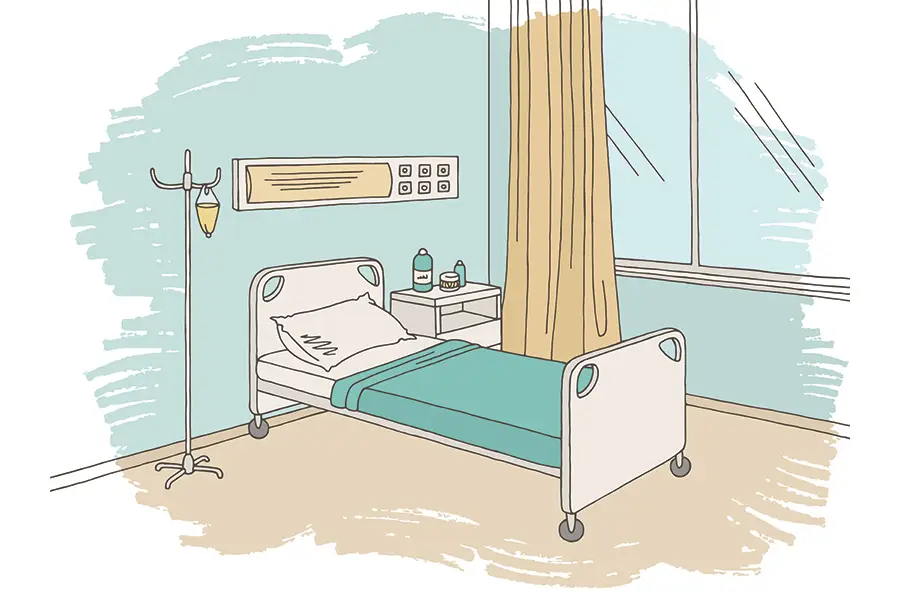Stuck In Bed
Uncovering the Truth About an Aging Population’s Impact on Healthcare
Across New Hampshire and Vermont, patients who no longer have acute care needs—medical care for short-term, severe illnesses or injuries that require immediate attention—are “stuck” in hospital beds awaiting to be discharged home or to a rehabilitation or long-term care facility.
Several factors—an aging population, housing concerns, insurance issues, the lack of availability of post-hospital specialized services, and access to basic transportation—have turned hospitals into a social safety net for our most vulnerable populations. These factors significantly impact the delivery of health care to the entire population.
Demographic Shifts
The fastest-growing age group in the United States is those aged 85 and older. New Hampshire has the second-oldest median age population nationwide: more than 20% of the state’s population is over 65. As the state’s largest health system, Dartmouth Health is at the epicenter of aging.
This unprecedented demographic shift is more than a rude awakening for hospitals and health systems. It’s a wake-up call like no other—a global public health crisis with no fast or straightforward solutions.
These challenges aren’t unique to older patients. The barriers to discharging patients with more complex health challenges increasingly threaten timely and efficient care for people of all ages.
Healthcare Worker Shortages — Supply Versus Demand
Quite simply, there are not enough healthcare workers or post-acute care facilities to support and sustain the needs of our aging population. Without more skilled workers and safe places to discharge patients, hospitals remain overwhelmed by backlogs of boarders. This dilemma limits admission capacity for new patients who need high levels of care. Although identifying this pipeline problem is easy, solving it is a challenge requiring broad-scale public awareness, political action, and systemic intervention.
Such critical bed shortages are due, in large part, to systemic societal shifts toward aging populations with longer life expectancies, healthcare worker shortages, emergency department overcrowding, and multiple complex barriers to hospital discharge.
Case
in Point
An elderly woman suffering from dementia was brought to Dartmouth Health ED without identification.
Dartmouth Heath's Complex Care Team worked to identify her, obtain guardianship, access her financial power of attorney, and navigate Medicaid on her behalf to secure her care benefits.
She was discharged 176 days beyond what was medically necessary.
New Challenges =
New Terminology
Boarding: Holding a patient in the emergency department ED, often in hallways, after they have been admitted because there are no inpatient beds available
Exit Block: Occurs when patients in the ED requiring inpatient care are unable to gain access to appropriate hospital beds within a reasonable time frame
The American Association of Medical Colleges (AAMC) predicts a shortage of as many as 122,000 physicians by 2032
Even if healthcare use patterns were immediately equalized across race, insurance coverage, and geographic location, the United States would need an additional 95,900 doctors.
America's entire healthcare system is challenged, and our long-term care partners face the same issues of understaffing, cost increases, and decreasing funding sources as our hospitals and clinics. Some additional factors contributing to this crisis include:
Social Pressures
- Rising housing insecurity
- Increased cost of utilities
- Lack of aging resources for families
- Increased cost of self care
- High rate of substance use disorder (SUD)
Financial Barriers
- Long Medicaid intake processing times for long-term care
- Lack of post-acute payment source
- Increased complexity of reimbursement due to the prevalence of managed plans
External Markets
- Lack of beds for high-complexity, post-acute care
- Challenging primary care market
- Limited home health availability
- Diminished workforce capacity due to workforce contraction
- Inadequate third-party transportation resources
The Aftereffects of Overcrowded Healthcare Systems
- Delays in the treatment of patients due to lack of suitable spaces
- Treatments are administered in other spaces, including corridors
- Prolonged, unnecessary patient stays at the end of medical treatments pending transfers to units
- Inability to care for patients being transported by ambulance.
- Obstruction of the entry and exit routes of emergency departments
Unclogging the Public Health Pipeline
Many suggestions have been made to address this healthcare crisis and support our patients. At the national and state levels, increasing Medicaid reimbursement and investing in workforce development have been prominently suggested.
Dartmouth Health continues developing solutions to address this public health crisis as part of our commitment to weaving world-class care into our communities.
- Dartmouth Health supports a special fund that allows LTC facilities to admit patients with a pending long-term Medicaid application.
- Dartmouth Health also supports a bill that expands eligibility and increases reimbursement for Public Guardians.
- The Dartmouth Health Workforce Readiness Institute is partnered with New Hampshire’s Department of Education to ensure training and career advancement opportunities.
- Our Aging Resource Center is focused on helping older adults navigate a myriad of complex mental and physical health issues.
- In addition, in 2019, Dartmouth Health established its Geriatric Emergency Department as part of an effort to reduce the risk of ED revisits and avoid re-hospitalizations.





